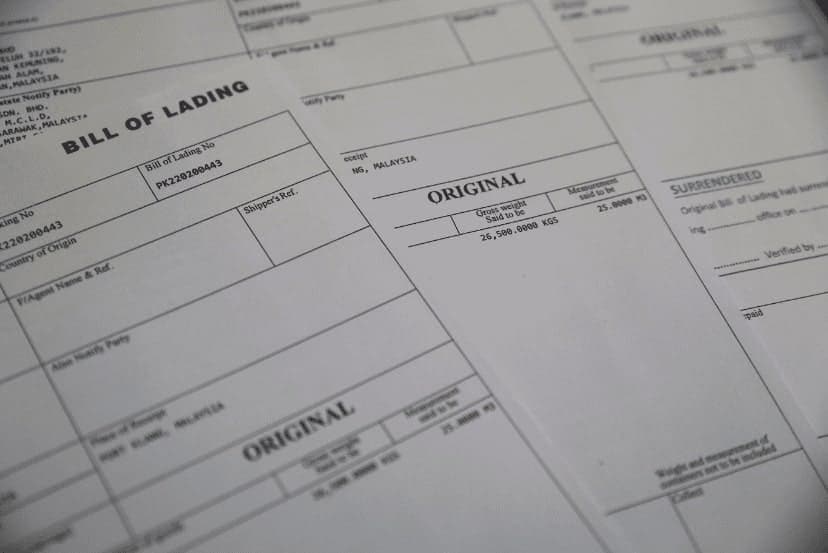Did you know that the global shipping industry moves over 11 billion tons of goods each year, connecting continents and making our interconnected world tick like a well-oiled machine? Now, imagine this vast maritime network as a giant puzzle, with each shipment having its own passport—the House Bill of Lading.
Welcome aboard as we dive into the fascinating world of the House Bill of Lading, a document that’s as essential to international trade as wind is to sails.
In this blog, we’re about to unravel the secrets behind this seemingly mundane piece of paper, exploring its meaning, decoding its format, and understanding why it holds the key to the seamless flow of products across the seven seas.
Get ready for a voyage of discovery as we navigate through the waters of shipping, demystifying the language of trade in a way that’s as easy as a gentle breeze on the open sea!
What is a House Bill of Lading?
A House Bill of Lading (HBL) is a crucial document in the realm of international shipping and trade. Think of it as a passport for your goods as they embark on a journey across the seas. Essentially, the HBL serves as a detailed receipt of the cargo, outlining the terms and conditions of the transportation agreement between the shipper (the one sending the goods) and the carrier (the entity responsible for transporting them).
Unlike its counterpart, the Master Bill of Lading issued by the main carrier, the House Bill of Lading is issued by a freight forwarder or a Non-Vessel Operating Common Carrier (NVOCC). This document comes into play when a shipment involves multiple modes of transport or when various carriers are handling different legs of the journey.
In simpler terms, the House Bill of Lading is your ticket to tracking your cargo’s progress across the globe, ensuring a smooth voyage from the warehouse to the recipient’s doorstep. It not only serves as a receipt but also as a document of title, enabling the transfer of ownership and facilitating the release of goods upon arrival at the destination. So, next time you hear about the House Bill of Lading, remember—it’s not just paper; it’s the captain’s log for your goods on their high seas adventure!
Also Read : Bill of Lading: Meaning, Types, Example, and Purpose
Cargo Chronicles: Unveiling the House Bill of Lading Symphony
Within the folds of the House Bill of Lading lies a comprehensive dossier, detailing the intricate dance of goods traversing the global trade stage. Here’s a sneak peek into its contents:
Supplier’s Vital Stats: The document kicks off with the who’s who of the export party—the name and address of the supplier, the mastermind behind dispatching the goods.
Consignee Chronicles: On the flip side, we’ve got the importer, the receiver, or as we like to call them—the consignee. Their name and address take center stage, marking the destination of this cargo odyssey.
Cargo Blueprint: Ever wondered about the nitty-gritty of the items making the grand journey? Look no further—the House Bill of Lading spills the beans on dimensions, weight, classification, container types, and any other vital details about the cargo’s physical makeup.
Monetary Manifest: What’s a journey without knowing the treasures on board? The document also encapsulates the value of the cargo, ensuring everyone is on the same page regarding the financial stakes involved.
Transportation Tango: Whether it’s a smooth sail or an air-bound adventure, the House Bill of Lading discloses the chosen mode of transportation, setting the rhythm for the entire logistical symphony.
Shipment Script: Last but not least, the terms of shipment take the spotlight. From Incoterms to contractual agreements, this section clarifies the rules of engagement, ensuring a harmonious expedition from port to port.
In essence, the House Bill of Lading isn’t just a mundane checklist; it’s a narrative, weaving together the essential elements that transform a cargo shipment into a well-choreographed spectacle of international trade.
Why the House Bill of Lading Matters in Shipping?
The House Bill of Lading stands as a formal acknowledgment, signaling that the carrier has not only received the consignment but has also meticulously inspected it before the impending journey. This document serves as a guarantee, affirming that the goods are intact and ready for their expedition to the awaiting consignee. Should any unfortunate mishaps occur during transit, the responsibility squarely rests on the carrier’s shoulders.
Beyond its role as a receipt, the House Bill of Lading plays a crucial part in establishing a contractual agreement for the transportation of cargo. It’s not merely a paper trail for ships, trains, or airplanes; instead, it solidifies the pact between the supplier and the carrier company. Any hiccups encountered during the shipping process are a matter to be resolved between these key players, not the specific mode of transportation.
Moreover, this document empowers the carrier to assume legal custodianship of the consignment if the recipient falters in furnishing the necessary documentation at the destination. The carrier retains the authority to withhold the goods until the consignee arrives armed with the correct paperwork.
By holding the carrier accountable for releasing goods exclusively to the rightful recipient, the House Bill of Lading ensures compliance with legalities. Deviating from this protocol places the carrier in a precarious legal position.
To keep tabs on this orchestrated journey, the House Bill of Lading relies on a unique identifier—the Bill of Lading Number—etched on the document, making tracking a streamlined affair in the intricate world of shipping.
What Does a House Bill of Lading Contains?
A House Bill of Lading (HBL) is a comprehensive document that encapsulates crucial information about a shipment, serving as a key instrument in international trade. Here’s an overview of what a House Bill of Lading typically contains:
Shipper Details
Name and address of the supplier or exporter initiating the shipment.
Consignee Details
Name and address of the receiver or importer, designating the final destination of the goods.
Description of Goods
Comprehensive information about the items being shipped, including dimensions, weight, classification, type of container, and any specific handling instructions.
Value of Goods
The declared or invoiced value of the goods being transported, providing a basis for customs valuation and insurance coverage.
Mode of Transportation
Indication of the chosen mode of transportation, whether it’s by sea, air, rail, or a combination of these, along with relevant details such as vessel or flight information.
Terms of Shipment
The agreed-upon terms between the buyer and seller, often specified using Incoterms, which delineate the responsibilities and costs associated with the transportation and delivery of the goods.
Bill of Lading Number
A unique identifier assigned to the document, crucial for tracking and referencing the specific shipment.
Date of Issue
The date when the House Bill of Lading is issued, providing a chronological reference point for the entire shipment process.
Carrier’s Liability and Notations
Any remarks or notations made by the carrier regarding the condition of the goods at the time of receipt, indicating whether any visible damage or discrepancies were observed.
Special Instructions
Any special handling or care instructions for the carrier, ensuring that fragile or sensitive items are treated accordingly.
Signature and Seal
The signature of the carrier or its representative, along with any official seals, validating the document’s authenticity.
The House Bill of Lading is a dynamic document that evolves as the goods move through the various stages of transportation. Its content is critical for legal, logistical, and financial purposes, providing a comprehensive record of the shipment and serving as a guide for all parties involved in the trade transaction.
House Bill of Lading Format
(add the format image here)
Decoding House Bills of Lading: Contrasts in FCL and LCL Operations
House Bill of Lading (HBL) Issued Under FCL:
Single Seller-Buyer Coordination: In FCL (Full Container Load), there’s one seller and one buyer in each country coordinating with respective freight forwarders.
One House Bill of Lading (HBL): A solitary House Bill of Lading is issued against a Master Bill of Lading, streamlining the documentation process.
House Bill of Lading (HBL) Issued Under LCL:
Multiple Suppliers: In LCL (Less than Container Load), a single Master Bill of Lading can accommodate multiple House Bills of Lading.
Diverse Suppliers, Same Container: Several suppliers, each shipping goods in the same container, receive individual House Bills of Lading.
Versatility in Coordination: Despite the multiple House Bills, the overall process remains consistent, involving coordination between sellers, buyers, and freight forwarders.
Negotiability of the House Bill of Lading
The negotiability of the House Bill of Lading (HBL) plays a pivotal role in international trade transactions, offering a level of flexibility and security to parties involved in the shipment process. Unlike its cousin, the Ocean Bill of Lading, which is typically non-negotiable, the HBL often holds negotiable status. This means that it can be transferred from the original shipper to other parties along the supply chain, providing a mechanism for the transfer of goods’ ownership.
In essence, the negotiability of the HBL enables it to function as a document of title, akin to a negotiable instrument or a promissory note. The holder of the HBL, often the consignee or a third party, gains the right to claim the goods upon presentation of the original document. This feature adds a layer of financial security and ease of trade, allowing transactions to occur smoothly even as the goods traverse various transportation modes and change hands.
The negotiation process involves the endorsement and transfer of the original HBL, making it a valuable instrument for parties involved in the logistics chain. Financial institutions, such as banks and letter of credit issuers, recognize the negotiable HBL as a tangible asset that can be used in trade financing, providing working capital to businesses engaged in international commerce.
However, it’s crucial to note that the negotiability of the HBL comes with its own set of complexities. The terms and conditions specified in the document, including any clauses or restrictions, should be carefully examined during the negotiation process to avoid disputes or discrepancies.
In conclusion, the negotiability of the House Bill of Lading enhances the fluidity of international trade by facilitating the transfer of ownership and providing a reliable mechanism for financial transactions. This characteristic transforms the HBL from a mere shipping receipt into a valuable and tradable instrument in the intricate web of global commerce.
Benefits of a House Bill of Lading?
The House Bill of Lading (HBL) offers a multitude of benefits in the complex landscape of international shipping and trade. Here are some key advantages:
Document of Title: The HBL serves as a document of title, providing proof of ownership of the shipped goods. This feature facilitates the transfer of ownership during the course of the shipment, offering a level of security and control in trade transactions.
Transferability: The negotiability of the HBL allows for its transfer between parties along the supply chain. This feature enhances flexibility in trade transactions, enabling the easy transfer of rights to claim the goods to different entities, such as consignees, banks, or other intermediaries.
Trade Financing: Financial institutions recognize the HBL as a valuable asset, often accepting it as collateral for trade financing. This allows businesses engaged in international trade to access working capital based on the value of the goods in transit, providing a crucial financial lifeline.
Smooth Customs Clearance: The HBL serves as a comprehensive document, detailing information about the shipped goods. This facilitates smoother customs clearance processes, reducing the likelihood of delays and ensuring that the cargo reaches its destination efficiently.
Legal Protection: The HBL outlines the terms and conditions of the shipping agreement, providing legal protection for both the shipper and the carrier. In case of disputes or discrepancies, the HBL serves as a crucial reference point, helping to resolve issues in a transparent manner.
Tracking and Accountability: With a unique Bill of Lading number, the HBL allows for effective tracking of the cargo throughout its journey. This enhances accountability, providing visibility into the location and status of the goods at various stages of transportation.
Efficient Logistics Management: For shipments involving multiple modes of transport or various carriers, the HBL streamlines logistics management. It consolidates information, making it easier to coordinate and manage the movement of goods across different transportation channels.
Insurance Purposes: The HBL often serves as a key document for insurance purposes. It provides essential details about the nature of the goods, their value, and the agreed-upon terms of shipment, aiding in the procurement of suitable insurance coverage for the cargo.
In summary, the House Bill of Lading is a fundamental document that not only facilitates the physical movement of goods but also plays a crucial role in ensuring the efficiency, security, and legality of international trade transactions.
Voyage of Legal Clarity
The Terms and Conditions outlined in a House Bill of Lading (HBL) serve as the compass guiding the intricate voyage of international shipping. Within this document, key terms such as Carrier, Merchant, Goods, Container, Carriage, Combined Transport, Hague Rules, Hague-Visby Rules, COGSA-Carriage of Goods by Sea Act, COGWA-Carriage of Goods by Water Act, Charges, Shipping Unit, Person, and Stuffed are precisely defined, creating a comprehensive framework for the contractual relationship.
An illuminating aspect of the HBL is its detailed insight into the Carrier’s tariff. Any provisions, if present, are seamlessly integrated into the bill, obtainable directly from the carrier. In the event of a disparity between the applicable tariff and the House Bill, precedence is given to the latter.
Emphasizing its non-negotiable nature, the HBL becomes a powerful instrument when specific conditions are incorporated. The authority of holding or receiving adheres strictly to these conditions. Acting as prima facie evidence, the HBL enables the carrier to assert the lawful transportation of goods, though the presentation of correct supporting documents remains essential, except when explicitly stated otherwise.
The HBL grants the carrier the flexibility to subcontract for a part or the entirety of the voyage, absolving them from disputes, which are to be resolved directly between the shipper and the carrier company, not involving the vessel.
Navigating through international waters requires adherence to varying rules, and the carrier’s responsibility is confined strictly to port-to-port, excluding other transit points. General provisions address delay, consequential loss, limitations on packages or shipping units, Ad Valorem (Declared value of the cargo), notice of loss or damage, rust provisions, and time-bar.
Merchant responsibilities, acceptable container filling levels, provisions for temperature-controlled cargo, and inspection guidelines are explicitly stated. The HBL also encapsulates details such as cargo description, deck cargo, and live stock, ensuring a comprehensive understanding of the shipped goods.
Additionally, the terms and conditions elucidate charges for shipment, custody of goods, and lien, with no waivers unless explicitly provided for in the HBL. Applicable laws governing the voyage are clearly articulated, ensuring legal adherence.
Furthermore, the HBL addresses the handling of personal data and information, establishing a framework for responsible data sharing among the involved parties. In essence, the HBL’s Terms and Conditions serve as the bedrock, fostering a transparent, secure, and legally sound journey for goods in the realm of international trade.
Also Read: Exploring the Diverse Types of Bill of Lading in Shipping
Crafting a Comprehensive House Bill of Lading
Issuing and creating a House Bill of Lading (HBL) involves several key steps to ensure accuracy, legality, and transparency in international shipping. Here’s a simplified guide:
Gather Information
Collect essential details about the shipment, including the names and addresses of the shipper (exporter) and consignee (importer), description of goods, quantity, weight, and any special handling instructions.
Select a Format
Choose a standard format for the House Bill of Lading. While there are templates available, it’s crucial to tailor the document to your specific shipment requirements.
Include Key Terms
Clearly define terms such as Carrier, Merchant, Goods, Container, Carriage, and any other relevant terms based on the specific details of your shipment.
Specify Mode of Transport
Indicate the mode of transportation (sea, air, rail, etc.) and provide details such as vessel/flight information and the expected route.
Incorporate Incoterms
Specify the agreed-upon terms of shipment using Incoterms, outlining the responsibilities and costs between the buyer and seller.
Mention Bill of Lading Number
Assign a unique Bill of Lading number to the document. This identifier is crucial for tracking and referencing the specific shipment.
Include Date of Issue
Clearly state the date when the House Bill of Lading is issued. This helps establish a chronological record of the shipping process.
Define Carrier’s Liability
Clearly articulate the carrier’s liability and any notations regarding the condition of the goods at the time of receipt. This provides a legal foundation for the transportation.
Address Special Instructions
If there are any special handling instructions or requirements, include them in the document to ensure proper treatment of the goods.
Address Third-Party Carrier (H3)
If applicable, mention any third-party carriers involved and specify if they are acting in good faith.
Include Legal Provisions
Address legal provisions related to delays, consequential loss, limitations on packages or shipping units, Ad Valorem, notice of loss or damage, rust provisions, time-bar, and any other relevant legal considerations.
Merchant’s Responsibilities
Clearly state the responsibilities of the merchant during the voyage, acceptable container filling levels, provisions for temperature-controlled cargo, and guidelines for the inspection of goods.
Description of Cargo
Include a detailed description of the cargo, addressing specific items, deck cargo, live stock, and any other relevant details.
Specify Charges
Clearly state different charges associated with the shipment, custody of goods, and any lien conditions.
Comply with Applicable Laws
Clearly articulate the applicable laws governing the voyage to ensure legal compliance.
Handle Personal Data
Clearly define how personal data and information will be handled, ensuring compliance with data sharing requirements.
Verification and Review
Before finalizing the House Bill of Lading, thoroughly review the document to ensure accuracy, completeness, and adherence to legal and contractual requirements.
Distribution
Once verified, distribute copies of the House Bill of Lading to all relevant parties, including the shipper, consignee, carriers, and any other involved entities.
Retain Copies
Keep copies of the issued House Bill of Lading for record-keeping and reference purposes.
Consider Professional Assistance
In complex international trade scenarios, consider seeking professional assistance or legal advice to ensure that the House Bill of Lading complies with all relevant regulations and contractual obligations.
By following these steps, you can issue and create a House Bill of Lading that serves as a reliable and legally sound document for the smooth execution of international shipments.
Final Words
Imagine the world of trade as a big ocean, and the House Bill of Lading is like the silent hero making sure everything flows smoothly. It’s not just a piece of paper; it’s like a passport for goods, helping them travel across the world. We’ve explored what makes this document special, like a storybook for each shipment. As we finish our journey, remember, the House Bill of Lading is more than paperwork – it’s the guide ensuring goods travel legally and safely. Wishing you calm seas and good luck in all your future shipments!
Also Read: Best Ways to Track Bill of Lading in 2023





